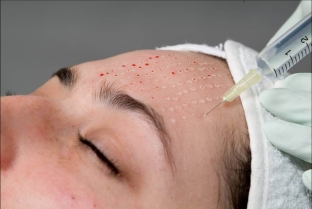Today, injection cosmetology is one of the most popular methods of rejuvenation and improvement of the properties and appearance of the skin. As you know, in cosmetics for external use, a sufficiently large number of useful components cannot be used, since they are not able to penetrate the epidermal barrier.
Injections make it possible to deliver active substances directly to the dermis, and bioreparation – this is one of those methods, helping to restore the beauty and youthfulness of the skin. Read more on estet-portal.com about the features of the bioreparation procedure.
Skin bioreparation – effective rejuvenating treatment
Bioreparation procedure – this is the intradermal administration of certain drugs, which include hyaluronic acid, as well as proteins, amino acids and vitamins. All these components create a "depot" in the skin. important substances, where they can stay for more than two weeks and start natural regeneration processes.
The use of preparations for bioreparation of the skin makes it possible to restore its important functions, compensate for the lack of hyaluronic acid and other important components, and improve the appearance of the skin as a whole.
Reviews of patients who have undergone a course of bioreparation confirm the high efficiency of this procedure.
Bioreparation:
- indications and contraindications for the bioreparation procedure;
- features of the bioreparation procedure: technique of execution;
- how does the bioreparation procedure differ from biorevitalization.
Indications and contraindications for bioreparation procedure
The skin biorepair procedure has a number of indications that a specialist must consider before recommending it to a patient. These include:
- gravitational skin ptosis;
- dry and sensitive skin;
- signs of photoaging and chronoaging of the skin;
- acne disease;
- presence of scars and stretch marks on the skin;
- cellulite;
- flabbiness of the skin of the hands;
- skin condition after aggressive anti-aging techniques.
The bioreparation procedure may be contraindicated in case of serious diseases of the body, such as diabetes mellitus, autoimmune pathologies, disorders of the blood coagulation system, as well as in oncopathologies and skin infections, allergic reactions to the components of the drug for bioreparation.
Features of the bioreparation procedure: technique of execution
As mentioned above, the bioreparation procedure is one of the injection methods of rejuvenation and improvement of skin properties. If necessary, the patient is given local anesthesia before the procedure. The bioreparation technique has its own characteristics. The patient's face, neck and décolleté are treated with "papular" method.
Why do papules appear and when do they disappear after biorevitalization
On the face, injections are carried out along massage lines, on the neck – along arcuate lines, and the neckline is chipped along V-shaped lines. After the procedure, the skin is lubricated with a soothing and regenerating cream. To achieve the maximum effect after bioreparation, the patient is recommended to undergo a course of three procedures with an interval of 3 weeks between them.

How does the bioreparation procedure differ from biorevitalization
Bioreparation can be called a kind of round in the evolution of the popular biorevitalization procedure. Both methods are in many ways similar to each other, and their main difference is the composition of the injected drug. Biorevitalization involves the introduction of only hyaluronic acid into the dermis, which can be in the skin for up to 72 hours, so the effect of the procedure does not last so long.
The biorevitalization procedure will help prepare the procedure for the summer
During bioreparation, the same hyaluronic acid is injected into the skin, but in combination with other useful components, such as amino acids, vitamins and peptides, due to which the drug remains in the skin for up to 3 weeks, creating a supply of nutrients.
Bioreparation – this is an effective way to saturate the skin with useful substances that it lacks.
The patient can appreciate the visible effect already after the first procedure, but the maximum results can be achieved only after a course of procedures. In the section «Cosmetology» read more articles about injection techniques on estet-portal.com.







Add a comment